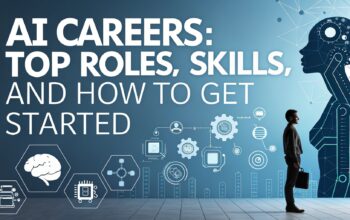A layman’s guide to the architecture behind ChatGPT. Learn how ChatGPT works in simple terms—perfect for students and professionals alike.
Introduction: Why Everyone’s Talking About ChatGPT
In the last few years, AI has made huge leaps, and ChatGPT is at the center of it all. Whether you’re a student curious about how AI understands you or a professional looking to apply it at work, understanding how ChatGPT works can give you an edge.
But what actually powers this intelligent chatbot? Let’s break it down.
What Is ChatGPT?
Before diving into how ChatGPT works, it helps to understand what it is. ChatGPT is a language model developed by OpenAI. Simply put, it’s an AI system trained to understand and generate human-like text.
Unlike traditional software that follows strict commands, ChatGPT “learns” from vast amounts of data. It reads, processes, and responds in a way that feels natural—like you’re chatting with a person.
How ChatGPT Works: The Core Architecture
At its heart, ChatGPT is based on a model called GPT, which stands for Generative Pre-trained Transformer. This is a type of deep learning architecture that processes language using something called a transformer network.
The Training Process
Here’s how ChatGPT works during training:
- Step 1: Pre-training
ChatGPT first reads a huge volume of internet text to learn grammar, facts, and reasoning skills. - Step 2: Fine-tuning
After pre-training, it’s fine-tuned on more specific conversations using human feedback. This step helps it sound more helpful and safe. - Step 3: Reinforcement Learning
Developers use Reinforcement Learning with Human Feedback (RLHF) to improve responses. It rewards better answers, much like teaching a child with praise.
Understanding the “Transformer” in ChatGPT
The transformer is a deep learning model designed to handle language tasks. It doesn’t just read one word at a time—it processes entire chunks of text using “attention mechanisms.” This helps it focus on what’s important in a sentence.
So when you ask a question, ChatGPT doesn’t just look at each word—it considers the context and meaning of your entire message. That’s the secret behind how ChatGPT works so effectively.
How ChatGPT Generates a Response
When you input a prompt, here’s how ChatGPT works to craft a response:
- Tokenization – Your input is broken down into small chunks called tokens.
- Context Analysis – The model considers all the tokens and context.
- Prediction – It predicts the most likely next token… then the next, and so on.
- Response Output – Finally, it strings together those tokens into human-readable text.
Thanks to millions of training examples, the model becomes incredibly good at giving smart, useful answers.
Real-World Uses of ChatGPT
Now that you know how ChatGPT works, it’s easy to see why it’s so popular. Here are a few real-world applications:
- Students use it for study help, summaries, and coding tips.
- Professionals apply it in customer support, content writing, and workflow automation.
- Researchers and developers even build apps on top of ChatGPT for more advanced use cases.
Limitations You Should Know
While it feels smart, ChatGPT isn’t perfect. It doesn’t truly “understand” things the way humans do. Sometimes it may sound confident but give incorrect answers. Also, since its data isn’t always up-to-date, it’s not great with real-time events unless integrated with live tools.
Knowing how ChatGPT works also means recognizing its limitations.
Future of ChatGPT and AI Conversations
The evolution of models like ChatGPT is ongoing. OpenAI continues to improve it, making it safer, faster, and more aligned with human values. As users, understanding how ChatGPT works helps us use it more responsibly and creatively.
To sum up, ChatGPT uses deep learning, specifically transformers, to understand and generate human-like responses. From tokenizing text to applying attention mechanisms, each step plays a vital role. Knowing how ChatGPT works isn’t just a technical curiosity—it’s a practical skill in today’s AI-driven world.
FAQs:
1. Is ChatGPT a search engine?
No, ChatGPT is not a search engine. It generates responses based on patterns it learned during training, not by looking up live data from the web.
2. Can ChatGPT learn from new conversations?
Not directly. It doesn’t update its knowledge in real-time from user chats unless retrained or updated by developers.
3. What makes ChatGPT different from other chatbots?
Its use of the transformer architecture and massive training data allows it to understand context better and respond more naturally.
4. Is ChatGPT safe to use for academic or professional work?
Yes, but it should be used with caution. Always verify critical information from reliable sources.
5. How does ChatGPT know what to say next?
It predicts the next word or phrase based on your input and the patterns it learned from training data.



